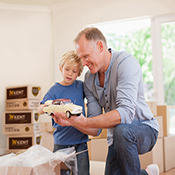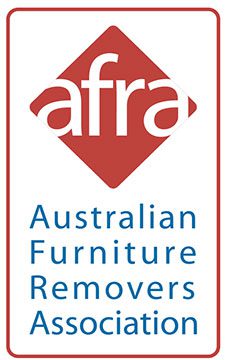Tip: Download a handy printable version of these Moving House Packing Tips at the bottom of this page.
When it comes to house moving, one of the most stressful things is packing. It’s time consuming, and trying to pack your things so they’re safe (and easy to find at the other end) can feel like an overwhelming task. So whether you’re moving house locally, interstate or moving overseas, it’s important you know how to pack for a move; otherwise your treasures might not arrive intact.
This moving house packing checklist can be used with our other checklists in our Moving House Checklists collection. It includes some practical ideas and our very best packing tips on moving house, collected over more than 75 years’ of moving Australians.
Moving and packing tips
Before you begin:
- Decide on packing needs: Choose which belongings you will pack and what gets left for the professional packers
- Source packing supplies: Choose only removalist-quality moving boxes and packing materials, purpose-designed for moving house
- Buy packing materials: Most people run out of packing materials (such as boxes, bubble wrap, tape, marker pens, small and large zip-lock bags) before they finish the job. So buy more than you think you’ll need to avoid untimely shopping trips. Also, go for white paper sheets (like ‘butcher’s paper’) over newspaper, as it won’t leave ink stains.
When packing:
- Where to begin: Start by packing the belongings you use least (such as books, CDs, DVDs and items stored in the roof space or garage)
- Work room by room: Pack one room at a time, keeping all the packed boxes for each room together
- Create a system: Clearly number and label every moving box you pack. Use a colour code to designate the room destination for each carton (use a different marker colour or label for each room)
- Label everything: Always label moving boxes with its contents, rather than just the room to which it belongs. This will help in the long-run if you’re looking for a specific item
- List contents: Prepare a separate inventory list detailing box numbers and contents
- Secure little things: Keep zip lock bags handy for small objects like screws and nuts
- Distribute weight: Pack heavy items on the bottom of the carton and lighter items on top
- Avoid overloading: Pack boxes to 20kg maximum for easy lifting and low risk of ‘giving out’
- Fill empty space: To help limit movement, use fabric, tea towels, clothing, paper, or bubble wrap to completely fill moving cartons. This also helps prevent boxes from collapsing
- Close boxes properly: Never pack a box that doesn’t close or has items sticking out the top. All your moving boxes should be properly closed and securely taped
- Use the right carton: Pack lighter items in bigger moving boxes and heavier items in smaller cartons
- Only use appropriate packing boxes: Never be tempted to pack goods inside cupboards and drawers. Furniture isn’t designed to be moved. Adding weight greatly increases the risk of movement damage in transit
- Consider your first night: Moving house can be a tiring exercise, particularly if you’re moving without the help of professional removalists. So, make sure anything you need to settle into your new home on your first night is easy to access. Consider packing a separate ‘First Night Box’ containing bed linen, towels, a change of clothes, and toiletries for all family members. This is often overlooked but is a lifesaver when it comes to house moving tips!
- Reinforce boxes: Securely tape the top, bottom and sides of every box
Top packing tips for tricky items
Furniture, oddly shaped bits and bobs, and things that take up lots of space (but don’t have to!) can be tricky to pack. Here’s a few tips to help with those more difficult items:
- Dismantle furniture: Break down items which come apart easily that you won’t need to use in the lead up to moving house. Kent’s professional removalists can also assist you with furniture dismantling services should you need them.
- Secure components: Put any removable hardware (like screws and bolts) from dismantled furniture into a clear plastic bag or container. Tape the bags to larger pieces of furniture or safely secure your container elsewhere
- To save on space:
- Flat pack or dismantle as much as possible
- Consolidate smaller objects that could go missing into a larger box
- Use vacuum seal bags for out-of-season clothing
- Make use of baskets, laundry bins and suitcases by packing things inside them (but never pack your treasures inside furniture, such as cupboards and drawers)
- Pack odd-shaped items in larger cartons to secure and stack them more efficiently
- Condense accessories: Remove accessories from sporting equipment (like bike pumps and water bottles) and pack together
- Pack plates upright: Stack plates vertically, like in the dishwasher, as they are less likely to break
- Take a picture: Before dismantling any computer equipment or electronics, photograph the cords and connections to help you remember where all the wires go
- Don’t risk spills: Drain garden hoses and tighten the lids on all jars or bottles in the pantry before packing
- Pack safely: Take special care when packing sharp objects, ensuring sharp edges are well insulated
- For the BBQ: Remove BBQ hoods, grills, hotplates and gas burners. Line a suitable carton with heavy-duty plastic and place all BBQ components in a box of their own
- Move safely: Do not pack dangerous goods such as corrosive, flammable, explosive, spontaneously combustible, toxic, oxidising or water-reactive goods. Items like LPG gas bottles and mower fuel fall into this category. For more information, download our Moving House Do’s and Don’ts list.
How to pack makeup
Remember these packing tips for moving house when it comes to moving cosmetics:
- If possible, pack makeup in a hard cosmetics case
- Separate liquids, creams, dry items and brushes
- Use zip-lock bags to separate eye, lip and nail products
- Cover the top of open toiletries with glad wrap, then screw lids back on
- Use an extra cotton pad or ball in cosmetic cases to help prevent breakage
- Put products like self-tan (that stain) in a plastic bag of their own.
For a free PDF of that you can have by your side, download our Moving House Packing List.
Make your move with Kent Removals & Storage today!
We hope these packing tips for moving house have helped you in the ‘how to pack’ department. Don’t forget Kent’s professional removalist packers are here to help if the job turns out to be bigger than expected. As far as moving and packing companies go, we’re one of the best in the business, with over 1 million removals under our belt. Plus there’s a whole collection of moving house checklists to use with these moving house packing tips.
How soon should you pack for a move?
Starting the packing process one to two months before the moving date is generally enough time to get everything sorted. That way, you have plenty of time to work methodically and won’t be flustered come moving day.
How do you pack for a move without getting overwhelmed?
Being organised is the key when it comes to staying calm during the packing process. Besides using our handy guide above, make sure you allow lots of time for planning, so that your packing process is all set out in advance. Also, make sure to book a removalist early (if you’re using one) so that you know you’re set for a relaxing and fuss-free moving day.
Master the art of packing with Kent Removals & Storage today. For professional packing and moving services, trust Kent to make the process smooth and stress-free. With over 75 years of relocation and storage experience, we’ve got you covered. Give our friendly team at Kent Removals & Storage a call on 13 55 31. Your peace of mind is just one phone call away!
Kent’s moving house packing tips icon image

How to pack for moving house checklist and tips image























